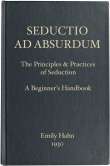You are here
قراءة كتاب Seductio Ad Absurdum The Principles & Practices of Seduction, A Beginner's Handbook
تنويه: تعرض هنا نبذة من اول ١٠ صفحات فقط من الكتاب الالكتروني، لقراءة الكتاب كاملا اضغط على الزر “اشتر الآن"

Seductio Ad Absurdum The Principles & Practices of Seduction, A Beginner's Handbook
href="@public@vhost@g@gutenberg@html@files@43757@[email protected]#f11" class="c12 pginternal" tag="{http://www.w3.org/1999/xhtml}a">[11] The Chinese with their customary reserve, make no mention of such matters in official papers, but a quantity of poetry and maxims discloses a keen Oriental interest in the topic.[12] The Old Testament abounds in stories of seduction by means of trickery, bribery and simple persuasion. It is safe to assume from the records that seduction in all parts of the civilized world was at about the same stage of primary development.
The Middle Ages show some progress. Literature was growing into an important culture, and we have much more source material. There are manifestations of refinement in the ancient game, but at the same time the world was not as light-hearted about these matters as it had been in the past. The growth of the Church, with its set ideas of these subjects and its zeal to catalogue the sins of mankind and to deal out punishment accordingly, gave to seduction its greatest impetus. At no other time in history has such a vast amount of time and thought been expended on one idea. It became a sin, and therefore a necessity.
Added to the stimulation of the churchly attitude was that of the caste system, which made seduction the only means of communication between the classes. The Renaissance introduced a new fashion, persuasion by means of bribery. Kings and their courtiers led the movement by elevating their mistresses to dizzy heights of power and wealth. The sixteenth, seventeenth and eighteenth centuries witnessed an influx of new families and the ascent of many a lowly maiden. Several of the noblest families of England trace their origin to such glittering seductions.[13] Indeed this process became at one time so notorious that it crept into folklore and has been preserved for us in many a ballad, of which the following is representative:
“She was poor but she was honest,
Victim of the Squire’s whim.”
Even before this period, England had introduced a variation of the art in the form of Chivalry. This school of behaviour, while professing an ignorance of the very rudiments of seduction, nevertheless played an important part in its development, as is convincingly illustrated by the old song:
“In days of old, when knights were bold
And barons held their sway,
A warrior bold, with spurs of gold,
Sang merrily his lay.”
But aside from the royal habits, there was no imagination, no finesse to seduction. It was a stereotyped affair, a furtive irregularity, a silly little sin. The seduction of the middle classes was a monotonous business, popular only by reason of the danger it entailed. It has remained for our modern world to raise it to a place of dignity among the leading interests of all society.
|
Bulfinch’s Mythology. |
|
The Golden Bough. Sir J. Frazer. |
|
The Kama Sutra. |
|
Colored Stars. E. Powys Mathers. Houghton Mifflin. |
|
Cf. The Complete Peerage. |
THIS MODERN WORLD
What are the reasons for this recent tendency? There are many answers. In the first place, mankind need no longer turn the whole of its energy to defence and sustenance. The life of the average man is not completely devoted to his business. He is a rarely active person if one-third of his day is given over to actual work.
“I work eight hours, I sleep eight hours,
That leaves eight hours for love.”
—Popular ballad
Otherwise what does he do with his time?
“What makes the business man tired?
What does the business man do?”
—Popular song
He reads, he plays, sometimes he wages war, and for the rest of the time he sleeps, eats and makes love. We find ourselves in a restless age, a time of experiment; when almost everyone is urged by the same desire to revise and improve.
It is the Golden Age of good living, consequently it is the age of impending boredom. In such an atmosphere we would expect to find a development of parlour pastimes. These conditions, this pleasant leisure, this much vaunted, generally diffused prosperity, this impatience for hallowed tradition and the time-honoured devices for improving one’s time, have given rise to crossword puzzles, introspection, and modern seduction.
DIFFICULTIES OF RESEARCH
Since the connotation of the word has been altered, I venture to assert that there have been converted to the practices of seduction at least twice as many devotees as had flourished before. This statement will undoubtedly be challenged: once more, I make no doubt, the skeptical will object to my conclusions on the grounds that a scientific recluse is of necessity withdrawn from the world and its customs and is thus automatically excluded as a responsible judge of sociological problems. It might be appropriate in this preface to enter a plea for our great body of research workers who are submitted to this sort of amateur criticism. The path of the scientist is beset with difficulties of every nature; not only those in the natural line of his work, but the wholesale hostility of the uninformed layman who does not understand the hardships and delays of laboratory procedure. In this case I hope to forestall criticism by claiming to have followed a conscientious program of newspaper reading. My statement is based on the knowledge common to the layman. I cite as proof the


